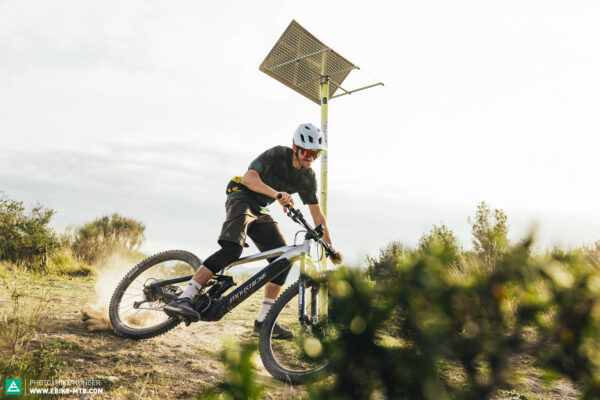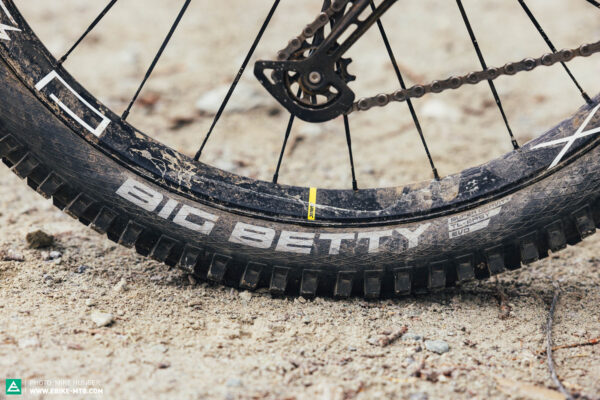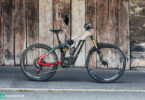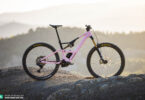What are the biggest differences between high-end eMTBs and the bikes in our 2023 group test of bikes below € 7,000? Where’s the potential and what can still be improved? Are everyday qualities and trail capability mutually exclusive? Here are 6 exciting findings from our 2023 e-mountainbike group test under € 7,000.

Blessing and curse: more integration also for e-mountainbikes under € 7000
Integration has long been one of the sector’s hot topics; something which is reflected in our group test under € 7,000. The most blatant example in this test field is the SCOTT Lumen eRIDE 910, which boasts next-level integration: the cables are routed internally through the headset, the display sits flush with the top tube and the drive system is seamlessly integrated into the bottom bracket – and even the shock is enclosed in the frame! Specialized didn’t mess around either, integrating the Mastermind display into the top tube and the motor system almost seamlessly into the frame of the Levo. This is the clear proof that the development efforts that are aimed initially at high-end models also trickle down to more affordable variants, which tend to rely on the same motor systems and integration as their bling counterparts – the main differences between models are in the spec.

However, our group test also shows that integration also has its drawbacks. The enclosed frame concept of the SCOTT Lumen eRIDE 910, for example, makes it hard to reach and set up the shock, despite the valve extension. Other popular features, like headset cable routing, can transform a simple maintenance task, i.e. replacing a cable, into a painful mission. If you aren’t a keen home mechanic and prefer to let your LBS take care of your bike, this might not be a problem, except for the additional costs this might involve. If you do the work yourself, however, you should prepare yourself for a rather unpleasant swear-athon. Furthermore, the battery of the SCOTT is integrated permanently into the frame and can’t be removed for charging, which clearly shows that integration can easily come at the expense of practicality. On the upside, the integrated battery ensures a super clean look, making the Lumen a clean, minimalistic trail bruiser. Furthermore, a higher level of integration allows manufacturers to improve the system’s functionality and the communication between its components.

Most e-mountainbikes aren’t true all-rounders out of the box
Let’s face it: most of the bikes in our 2023 group test under € 7,000 aren’t true all-rounders, which is somewhat understandable. Simply put, they’re all sporty eMTBs rather than trekking or SUV bikes. Straight out of the box, the bikes in this test simply lack the features that would make them suitable for everyday riding. And that’s a real issue, because most of the readers who took part in our annual reader’s survey stated that they’re intending to use their eMTBs both in everyday life and for touring. It’s rather frustrating that the BULLS SONIC EVO EN-SL1 is the only competitor in this test to come standard with an integrated headlightmount that draws its power directly from the main battery, and we’d love to see far more eMTBs with similarly clever light integration systems in the near future. A lighting system doesn’t bother you on the trail and brings along huge perks in everyday riding scenarios, whether you’re heading back home after a long day at the office or squeezing in a cheeky pint after an evening ride with your mates. Only two bikes in this test field have trailer approval, a feature that opens up countless transport possibilities and allows you to carry around pretty much anything you want to with your eMTB, from your kids to your four-legged sweetheart, and even a few bags of shopping. Whether you end up using the everyday features or not is another story, but it’s nice to have the option. Of course, no one’s forcing you to schlepp a trailer through town, but if you decide to do so, it’s great to know that your frame is covered by warranty if something goes wrong. Moreover, none of the bikes in this test has an effective anti-theft system. While Bosch’s e-bike lock function or Specialized’s system lock are nice features that shut off the bike and motor functions, full-on theft protection is a totally different thing! We’d love to see more effective anti-theft systems that give you extra peace of mind when jumping into the lake after a long day in the saddle.


For under € 7,000 you can get great eMTBs that also hold up against € 15,000 bikes
How much worse are eMTBs under €7,000 compared to their high-end counterparts? Some of them aren’t at all! The the RADON DEFT 10.0 750, which secured Best in Test in our huge 2023 e-mountainbike group test with 30 of the hottest bikes of the season, proved that it can keep up with bikes that are twice as expensive, and some of the bikes in our sub € 7,000group test delivered a similar performance. But why can more affordable bikes keep up with the pricier, top-tier models? How is that even possible? Because, in the high-end segment, the price gaps are huge, while the performance gains are marginal, with the biggest differences between lower and higher-end variants being the spec. Despite being significantly cheaper, low-to-medium range e-bikes tend to rely on the same motor systems, connectivity features and integration solutions as their expensive counterparts. Furthermore, it’s important to understand that a top-spec doesn’t necessarily translate into top performance. Bling components, like fancy carbon wheelsets, electronic drivetrains or futuristic cockpits, only bring marginal advantages in terms of performance while at the same time driving the price up significantly. Expensive high-end suspension can radically improve a bike’s performance for an experienced rider, but can be too complex to set up correctly for beginner riders, sometimes being more of a hindrance than a help. Beginners and tourers are often better off using a simple suspension setup that is quick and easy to adjust. That’s exactly why expensive doesn’t necessarily mean better!


Small upgrades, big results – It doesn’t take much to improve your eMTB
If you want to improve the performance of an affordable eMTB, you don’t necessarily have to spend lots of money. Even small, seemingly irrelevant upgrades can lead to big improvements and drastically boost a bike’s performance.
One of the simplest yet most effective upgrades are the brake rotors. Before upgrading to a more expensive brake model to make up for a lack of power, you should try bigger brake rotors. Generally speaking, higher-spec brakes only offer more adjustment options and lower weight than their cheaper counterparts, while bigger discs have a huge effect on the actual braking torque, giving rowdy trail shredders more oomph on long descents and touring riders extra peace of mind on long gravel descents. Most modern forks are officially approved for the huge 220 mm rotors, leaving plenty of room for improvement for most bikes.

If you read our reviews on a regular basis, you might have noticed that we complain a lot about tires: too thin, too hard, too narrow… and there’s a good reason! In this group test too, very few bikes have tires that are suitable for full-on trail fun! Once again, a small, relatively inexpensive upgrade will hugely improve your bike’s performance. For example, a front tire with a softer rubber compound will generate more traction and inspire far more confidence on the trail, especially in wet conditions – which is where most of us feel uneasy. At the same time, a softer front tire only has a marginal impact on rolling resistance, because we put far less pressure on the front wheel. A robust tire casing, on the other hand, offers better damping qualities, ensuring a more composed ride and fewer punctures. Moreover, a tougher casing allows you to run lower air pressures and let the tire absorb the small chatter, which will protect your hands and forearms from nasty vibrations without upgrading to any fancy forks.


Even without spending money on parts, you can adapt the character of your eMTB to suit your needs and preferences. For example, you can alter the cockpit height by adding or removing a few spacers under the stem. Riding downhill, a higher front end inspires confidence and prevents dreaded OTB moments, but also requires you to actively weight the front wheel in flat corners to keep it tracking. A lower cockpit, on the other hand, keeps the front wheel planted on steep climbs, but also puts more pressure on your hands, especially when riding on level ground. We recommend playing around with different spacer configurations until you find the sweet spot. If you do so, you’ll quickly realise that even one spacer makes a huge difference, changing the overall ride feeling rather radically – and don’t forget to tighten all the bolts again ;). Another thing that influences the ride feeling is the position of the saddle. Moving the saddle further forward can help with weight distribution on steep climbs, keeping the front end planted, while moving it further back can increase comfort and power output on flatter terrain, reducing the pressure on your hands for longer rides. Tweaking the angle by a degree or two might do your backside a favour too. Try it out!
More connectivity across the range
Even when spending less than € 7,000 on an e-mountainbike, you don’t necessarily have to renounce the latest innovative tech. With its new Shimano EP801 motor and electronic, fully-automatic Shimano XT Di2 drivetrain, the BULLS SONIC EVO EN-SL1 sets the ultimate standard for technology in the entry to medium-level range. Shimano bundle all of the functions into one app, which while not the most intuitive, offers near-endless customisation options, putting a massive grin on the face of technology nerds. However, BULLS isn’t the only manufacturer to play the connectivity card: the Specialized Levo Comp Alloy, for example, comes standard with an integrated Mastermind display in the top tube, which was previously exclusive to the Califiornian brand’s top-spec models. Not only does the display look great, but also provides far more riding data than the basic LED display found on the previous Levo models, opening up entirely new connectivity possibilities. When it comes to system control, Moustache don’t make any compromises either, providing their cheaper models with a high-quality Bosch Kiox 300 display.


Generally speaking, when buying a more affordable eMTB, you don’t have to renounce the latest motor technologies and connectivity features, because lower-end models rely on the same motors as their high-end counterparts, thus benefiting from the manufacturer’s same innovative power. Moreover, the bikes in our group test under € 7,000 can be updated just as easily as their expensive flagship counterparts, giving you the freedom to improve the parts you feel will benefit you the most.
Which frame material is the right one for an e-mountainbike?
In our latest e-mountainbike group test with a price cap, alloy frames make up the majority of the test field. 5 out of the 7 bikes in this test rely on welded tubes, while only two bikes – the SCOTT Lumen eRIDE 910 and the BULLS SONIC EVO EN-SL1 – employ a carbon frame. The advantages of carbon frames are obvious: the lightweight fibres allow for significantly lighter bikes and more freedom with frame designs. It’s no coincidence that the only carbon competitors in this test are also the lightest ones. Although the SCOTT is the only Light-eMTB in this test, the BULLS weighs nearly two kilograms less than the lightest alloy contestant, the Specialized Levo Comp Alloy. In terms of riding performance, weight plays a secondary role, and is subordinate to the consistency of the overall concept. With the BULLS, the low system weight clearly contributes to the agile handling, but we strongly doubt that Haibike’s trail tank, the Nduro 7, would suddenly become a nimble trail rocket if it shed a kilo or two with a lighter carbon frame. As a rule of thumb, a good alloy frame doesn’t have any drawbacks per se, and the performance of a bike is always down to these two magic words: overall concept.

The price tag of a bike doesn’t necessarily speak for its performance, and more than one bike in this test proved exactly this point! Some of the contestants in our 2023 e-mountainbike group test under €7,000 delivered a tremendous performance, both on the trail and with their mind-boggling level of connectivity and integration. However, many manufacturers still have to work hard to make their bikes trail ready straight out of the box and to make them real all-rounders!
Did you enjoy this article? If so, we would be stoked if you decide to support us with a monthly contribution. By becoming a supporter of E-MOUNTAINBIKE, you will help secure a sustainable future for high-quality cycling journalism. Click here to learn more.
Words & Photos: Felix Rauch









